The Human Genome Project (HGP), launched in 1990 and completed in 2003, aimed to map and sequence all human DNA, identifying approximately 20,000 to 25,000 genes. Utilizing techniques such as Sanger sequencing and shotgun sequencing, the project successfully completed the human genome sequencing ahead of schedule and under budget, at a cost of about $2.7 billion. The HGP also explored ethical, legal, and social issues related to genetic information, ensuring privacy and fairness in its application.

































